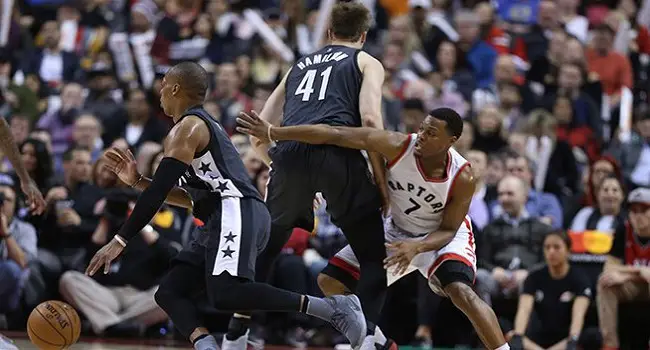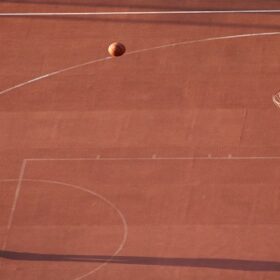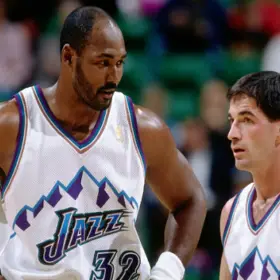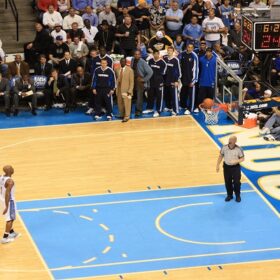If you are a fan of basketball or a player yourself, you will be familiar with the terms like a basketball screen, pick and roll, and pick and pop. Even if you don’t know what it is, you must have come across the term while in a basketball game or around.
A basketball screen is also known as pick and is one of the most popular offensive actions in the NBA. When you witness a basketball game, you will often find good teams setting effective screens and benefitting from it.
What Is A Screen In Basketball?
So what is a basketball screen? And how do you set an effective basketball screen? First off, a basketball screen is a legal block that an offensive player uses to deter the path of the defender. This helps the offensive player to screen the ball-handler by allowing more room for him to make an open pass or shoot or dive in for a goal.
It is always better if a bigger player sets the screen because he can take up a wider base while maintaining a firm position when the defender runs into him. If the screen is effective, it can be quite advantageous for the team. Not following the proper rules can lead to an illegal screen, which we have discussed in the previous article.
Since defenders are there for a reason, that is to defend, a screen or pick is an important method to fend off these defenders by guarding the ball-handler. When a screen is set, the opposing team’s defense becomes open. So naturally, the opponents will have to switch positions. This enables the offense to move in and take advantage of the open areas and increases the chance to score.
What Are The Different Kinds Of Screens In Basketball?
There are two categories of basketball screens – the off-ball screen and the on-ball screen. Each of these categories includes different kinds of basketball screens. It is important to know its uses before setting it.
Off-Ball Screen
This screen category is mainly used by players to give an opportunity to the teammates without the ball to make a score.
The different kinds of basketball screens included in this category are down screens, cross screens, and back screens, to name a few.
On-Ball Screen
On-ball screens are usually implemented in pick and rolls and generate a scoring opportunity to the ball-handler.
The basketball screens in this category include side screens, step up screens, and drag screens, among others.
Basketball Screen techniques
Setting an effective screen often requires a planned procedure. Here are the techniques to set a successful basketball screen.
If you are the screener or if you are the one who is setting the screen,
1. Make sure you are positioned firmly by keeping your legs apart, preferably wider than your shoulder-width with slightly bended knees. Keep your body in a vertical position. This will create a solid stance. After creating your position, take care not to move your feet; otherwise, it will lead to an illegal basketball screen, and you will be called for an offensive foul. If you remain stationary when the defender runs into you, the screen will be legal.
2. You can either cross your hands across your chest or hold them up so that the referee can make sure that you are not committing a foul by making illegal contact with the defender.
3. The important aspects of setting a screen are the angle and the timing of the screen. Although they are often overlooked, these aspects determine the effectiveness of a basketball screen. Anticipating the movement of your teammate will help you in creating a right angle screen. You should make sure that you are directly in the defensive opponent’s way. If your angle and timing are faulty, the defender will just slip past you.
4. Ensure that you are square to the defensive opponent. The middle of your chest should align with the hips and shoulder of the defender. Use these two body parts as your target.
5. Once you have set the screen, turn around and see if you are open for any probable pass. In most cases, the person who sets the screen is the one who is open.
If you are cutter or the person receiving the screen:
1. You should be able to set up the defender. Take a few steps away from the screen so that the defender does not see a screen coming. Make sure to properly position the screener before making a move to avoid a possible offensive foul.
2. Leading the defender in the opposite direction from the screen works most of the time. When you suddenly swerve back to the right direction, he will run straight into the screen.
3. Keep in mind to run shoulder to shoulder with the defender to avoid giving him room to get out of the screen. If you do this, he will either have to stay behind you or shove the screener, which will result in a defensive foul.
3 Advanced Basketball Screen Plays
Back-screen
Also known as the blind screen, a back-screen is typically set behind the defender’s back. This is mostly done with the screener in the opposite direction of the basket. To effectively set a back-screen, the screener should keep a distance of one step between him and the defender he is screening. A back-screen is an ideal basketball screen technique employed on the perimeter and the low post.
Flare-screen
A flare-screen is somewhat similar to a back-screen. It is usually set on the perimeter where the offensive player screens the defender on his back-side. The cutter then flares to an open area on the court for a pass and 3 point shot.
Cross-screen
In a basketball screen, a cross-screen is also called the lateral screen and is ideal in creating mismatches. In this technique, a screen is usually set on the perimeter for a post player. A cross-screen can also be set close to the high post across the free-throw line.
Conclusion
Keep in mind that no matter whether you are a beginner or a professional basketball player, being a good sportsman is what really matters in a basketball game. And by a good sportsman, I mean someone who abides by the rules of the game.
So it is always recommendable to carry on with your practices and not slack. Now that you know the theoretical basics of a basketball screen, it would be a good idea to take this information to the court for a practical session.






